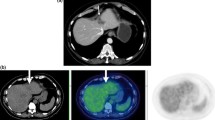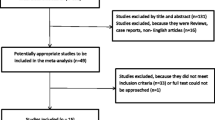Abstract
Purpose
The first aim of the review (aim 1) was to obtain the diagnostic performance values of 18F-FDG PET for the detection and staging of liver metastases in patients with colorectal cancer (CRC), the second aim (aim 2) was to compare PET and conventional imaging modalities, and the third aim (aim 3) was to evaluate the impact of PET on patient management. The incidence of extrahepatic disease (EHD) detected by PET is also reviewed.
Methods
A comprehensive search was performed on PubMed/MEDLINE for studies evaluating PET and PET/CT in CRC patients with liver metastases up to June 2014. For inclusion PET had to have been performed prior to surgery, there had to be at least 18 patients in the study, and the reported data had to allow calculation of 2 × 2 contingency tables (for aim 1). A total of 18 studies were eligible for at least one of the three intended subanalyses including a total of 1,059 patients. Pooled sensitivity, specificity and accuracy and the corresponding 95 % confidence intervals were derived from the contingency tables on a patient basis (patient-based analysis, PBA) and a lesion basis (lesion-based analysis, LBA) for eight studies.
Results
Pooled sensitivity and specificity of PET on PBA were both 93 %. Corresponding values for LBA were 60 % and 79 %, respectively. Areas under the summary ROC were 0.97 for PBA and 0.67 for LBA. Regarding aim 2, PET had a slightly lower sensitivity than MRI and CT on PBA (93 %, 100 % and 98 %, respectively) and LBA (66 %, 89 % and 79 %, respectively) but appeared to be more specific than MRI and CT (86 %, 81 % and 67 %, respectively). PET findings resulted in changes in the management of a mean of 24 % of patients. The mean incidence of PET-based EHD was 32 %.
Conclusion
This meta-analysis suggests that FDG PET/CT is highly accurate for the detection of liver metastases on a patient basis but less accurate on a lesion basis. Compared to MRI, PET is less sensitive but more specific and affects the management of about one-quarter of patients.




Similar content being viewed by others
References
Ismaili N. Treatment of colorectal liver metastases. World J Surg Oncol. 2011;9:154.
Kew MC. Sleisenger and Fordtran’s gastrointestinal and liver disease: pathophysiology/diagnosis/management. In: Feldman M, Friedman LS, Sleisenger MH, Scharschmidt BF, editors. Hepatic tumors and cysts. 7th ed. Philadelphia: Saunders; 2002.
Van Cutsem E, Nordlinger B, Adam R, Köhne CH, Pozzo C, Poston G, et al.; European Colorectal Metastases Treatment Group. Towards a pan-European consensus on the treatment of patients with colorectal liver metastases. Eur J Cancer. 2006;42(14):2212–21.
National Comprehensive Cancer Network. Clinical practice guidelines in oncology. Colon cancer version 1.2015. Fort Washington, PA: National Comprehensive Cancer Network. COL-B, page 2
Choti MA, Sitzmann JV, Tiburi MF, Sumetchotimetha W, Rangsin R, Schulick RD, et al. Trends in long-term survival following liver resection for hepatic colorectal metastases. Ann Surg. 2002;235(6):759–66.
Floriani I, Torri V, Rulli E, Garavaglia D, Compagnoni A, Salvolini L, et al. Performance of imaging modalities in diagnosis of liver metastases from colorectal cancer: a systematic review and meta-analysis. J Magn Reson Imaging. 2010;31(1):19–31.
Kekelidze M, D’Errico L, Pansini M, Tyndall A, Hohmann J. Colorectal cancer: current imaging methods and future perspectives for the diagnosis, staging and therapeutic response evaluation. World J Gastroenterol. 2013;19(46):8502–14.
Fletcher JW, Djulbegovic B, Soares HP, Siegel BA, Lowe VJ, Lyman GH, et al. Recommendations on the use of 18F-FDG PET in oncology. J Nucl Med. 2008;49(3):480–508.
Ruers TJ, Wiering B, van der Sijp JR, Roumen RM, de Jong KP, Comans EF, et al. Improved selection of patients for hepatic surgery of colorectal liver metastases with (18)F-FDG PET: a randomized study. J Nucl Med. 2009;50(7):1036–41.
Moulton CA, Gu CS, Law CH, Tandan VR, Hart R, Quan D, et al. Effect of PET before liver resection on surgical management for colorectal adenocarcinoma metastases: a randomized clinical trial. JAMA. 2014;311(18):1863–9.
Whiting PF, Rutjes AW, Westwood ME, Mallett S, Deeks JJ, Reitsma JB, et al. QUADAS-2: a revised tool for the quality assessment of diagnostic accuracy studies. Ann Intern Med. 2011;155(8):529–36.
Zamora J, Abraira V, Muriel A, Khan K, Coomarasamy A. Meta-DiSc: a software for meta-analysis of test accuracy data. BMC Med Res Methodol. 2006;6:31.
Coenegrachts K, De Geeter F, ter Beek L, Walgraeve N, Bipat S, Stoker J, et al. Comparison of MRI (including SS SE-EPI and SPIO-enhanced MRI) and FDG-PET/CT for the detection of colorectal liver metastases. Eur Radiol. 2009;19(2):370–9.
Huguet EL, Old S, Praseedom RK, Balan KK, Gibbs P, Jamieson NV. F18-FDG-PET evaluation of patients for resection of colorectal liver metastases. Hepatogastroenterology. 2007;54(78):1667–71.
Rappeport ED, Loft A, Berthelsen AK, von der Recke P, Larsen PN, Mogensen AM, et al. Contrast-enhanced FDG-PET/CT vs SPIO-enhanced MRI vs. FDG-PET vs. CT in patients with liver metastases from colorectal cancer: a prospective study with intraoperative confirmation. Acta Radiol. 2007;48(4):369–78.
Bacigalupo L, Aufort S, Eberlé MC, Assenat E, Ychou M, Gallix B. Assessment of liver metastases from colorectal adenocarcinoma following chemotherapy: SPIO-MRI versus FDG-PET/CT. Radiol Med. 2010;115(7):1087–100.
Akiyoshi T, Oya M, Fujimoto Y, Kuroyanagi H, Ueno M, Yamaguchi T, et al. Comparison of preoperative whole-body positron emission tomography with MDCT in patients with primary colorectal cancer. Colorectal Dis. 2009;11(5):464–9.
Chua SC, Groves AM, Kayani I, Menezes L, Gacinovic S, Du Y, et al. The impact of 18F-FDG PET/CT in patients with liver metastases. Eur J Nucl Med Mol Imaging. 2007;34(12):1906–14.
Ramos E, Valls C, Martinez L, Lladó L, Torras J, Ruiz S, et al. Preoperative staging of patients with liver metastases of colorectal carcinoma. Does PET/CT really add something to multidetector CT? Ann Surg Oncol. 2011;18(9):2654–61.
Selzner M, Hany TF, Wildbrett P, McCormack L, Kadry Z, Clavien PA. Does the novel PET/CT imaging modality impact on the treatment of patients with metastatic colorectal cancer of the liver? Ann Surg. 2004;240(6):1027–34.
Briggs RH, Chowdhury FU, Lodge JP, Scarsbrook AF. Clinical impact of FDG PET-CT in patients with potentially operable metastatic colorectal cancer. Clin Radiol. 2011;66(12):1167–74.
Joyce DL, Wahl RL, Patel PV, Schulick RD, Gearhart SL, Choti MA. Preoperative positron emission tomography to evaluate potentially resectable hepatic colorectal metastases. Arch Surg. 2006;141(12):1220–6.
Sørensen M, Mortensen FV, Høyer M, Vilstrup H, Keiding S; Liver Tumour Board at Aarhus University Hospital. FDG-PET improves management of patients with colorectal liver metastases allocated for local treatment: a consecutive prospective study. Scand J Surg. 2007;96(3):209–13.
Engledow AH, Skipworth JR, Pakzad F, Imber C, Ell PJ, Groves AM. The role of 18FDG PET/CT in the management of colorectal liver metastases. HPB (Oxford). 2012;14(1):20–5.
Bonanni L, De’liguori Carino N, Deshpande R, Ammori BJ, Sherlock DJ, Valle JW, et al. A comparison of diagnostic imaging modalities for colorectal liver metastases. Eur J Surg Oncol. 2014;40(5):545–50.
Lake ES, Wadhwani S, Subar D, Kauser A, Harris C, Chang D, et al. The influence of FDG PET-CT on the detection of extrahepatic disease in patients being considered for resection of colorectal liver metastasis. Ann R Coll Surg Engl. 2014;96(3):211–5.
Cantwell CP, Setty BN, Holalkere N, Sahani DV, Fischman AJ, Blake MA. Liver lesion detection and characterization in patients with colorectal cancer: a comparison of low radiation dose non-enhanced PET/CT, contrast-enhanced PET/CT, and liver MRI. J Comput Assist Tomogr. 2008;32(5):738–44.
Carnaghi C, Tronconi MC, Rimassa L, Tondulli L, Zuradelli M, Rodari M, et al. Utility of 18F-FDG PET and contrast-enhanced CT scan in the assessment of residual liver metastasis from colorectal cancer following adjuvant chemotherapy. Nucl Med Rev Cent East Eur. 2007;10(1):12–5.
Rojas Llimpe FL, Di Fabio F, Ercolani G, Giampalma E, Cappelli A, Serra C, et al. Imaging in resectable colorectal liver metastasis patients with or without preoperative chemotherapy: results of the PROMETEO-01 study. Br J Cancer. 2014;111(4):667–73.
Seo HJ, Kim MJ, Lee JD, Chung WS, Kim YE. Gadoxetate disodium-enhanced magnetic resonance imaging versus contrast-enhanced 18F-fluorodeoxyglucose positron emission tomography/computed tomography for the detection of colorectal liver metastases. Invest Radiol. 2011;46(9):548–55.
Niekel MC, Bipat S, Stoker J. Diagnostic imaging of colorectal liver metastases with CT, MR imaging, FDG PET, and/or FDG PET/CT: a meta-analysis of prospective studies including patients who have not previously undergone treatment. Radiology. 2010;257(3):674–84.
van Kessel CS, Buckens CF, van den Bosch MA, van Leeuwen MS, van Hillegersberg R, Verkooijen HM. Preoperative imaging of colorectal liver metastases after neoadjuvant chemotherapy: a meta-analysis. Ann Surg Oncol. 2012;19(9):2805–13.
Huebner RH, Park KC, Shepherd JE, Schwimmer J, Czernin J, Phelps ME, et al. A meta-analysis of the literature for whole-body FDG PET detection of recurrent colorectal cancer. J Nucl Med. 2000;41(7):1177–89.
Wiering B, Krabbe PF, Jager GJ, Oyen WJ, Ruers TJ. The impact of fluor-18-deoxyglucose-positron emission tomography in the management of colorectal liver metastases. Cancer. 2005;104(12):2658–70.
Petersen RK, Hess S, Alavi A, Høilund-Carlsen PF. Clinical impact of FDG-PET/CT on colorectal cancer staging and treatment strategy. Am J Nucl Med Mol Imaging. 2014;4(5):471–82.
Yang Y, Czernin J. Contribution of imaging to cancer care costs. J Nucl Med. 2011;52 Suppl 2:86S–92S.
Siepe B, Hoilund-Carlsen PF, Gerke O, Weber WA, Motschall E, Vach W. The move from accuracy studies to randomized trials in PET: current status and future directions. J Nucl Med. 2014;55(8):1228–34.
Conflicts of interest
None.
Author information
Authors and Affiliations
Corresponding author
Rights and permissions
About this article
Cite this article
Maffione, A.M., Lopci, E., Bluemel, C. et al. Diagnostic accuracy and impact on management of 18F-FDG PET and PET/CT in colorectal liver metastasis: a meta-analysis and systematic review. Eur J Nucl Med Mol Imaging 42, 152–163 (2015). https://doi.org/10.1007/s00259-014-2930-4
Received:
Accepted:
Published:
Issue Date:
DOI: https://doi.org/10.1007/s00259-014-2930-4




